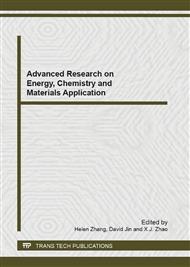[1]
XU Ying, LIU Hongyan. Development and Expectation of the Energy Plant [J]. Chinese Agricultural Science Bulletin, 25(03)( 2009), pp.297-300.
Google Scholar
[2]
Teresa M. Mata, Anto nio A. Martins and Nidia. S. Caetano. Microalgae for biodiesel production and other applications: A review[J]. Renewable and Sustainable Energy Reviews 14 (2010), p.217 –232.
DOI: 10.1016/j.rser.2009.07.020
Google Scholar
[3]
Tasneem Abbasi, S.A. Abbasi. Biomass energy and the environmental impacts associated with its production and utilization[J]. Renewable and Sustainable Energy Reviews 14(2010), p.919–937.
DOI: 10.1016/j.rser.2009.11.006
Google Scholar
[4]
Fergal O. Rourke, Fergal Boyle and Anthony Reynolds. Renewable energy resources and technologies applicable to Ireland[J]. Renewable and Sustainable Energy Reviews 13 (2009), p.1975 –(1984).
DOI: 10.1016/j.rser.2009.01.014
Google Scholar
[5]
Lian Pin Koh, Jaboury Ghazoul. Biofuels, biodiversity, and people: Understanding the conflicts and finding opportunities[J]. Biological Conservation 141 (2008), pp.2450-2460.
DOI: 10.1016/j.biocon.2008.08.005
Google Scholar
[6]
Xuguang Jiang, Chunyu Li, Yong Chi, et al. Thermal behavior characteristics of Adhesive residue[J]. Waste Management 29 (2009), p.2824–2829.
DOI: 10.1016/j.wasman.2009.07.003
Google Scholar
[7]
Hui Zhao, Huaxiao Yan, Shuangshuang Dong , et al. Thermogravimetry study of the pyrolytic characteristics and kinetics of macro-algae Macrocystis pyrifera residue[J]. Journal of Thermal Analysis and Calorimetry111(2013), p.1685–1690.
DOI: 10.1007/s10973-011-2102-8
Google Scholar
[8]
Guozhan Jiang, Daniel J. Nowakowski and Anthony V. Bridgwater. A systematic study of the kinetics of lignin pyrolysis[J]. Thermochimica Acta 498 (2010), p.61–66.
DOI: 10.1016/j.tca.2009.10.003
Google Scholar
[9]
A.B. Ross, J.M. Jones and M.L. Kubacki, et al. Classification of macroalgae as fuel and its thermochemical behaviour[J]. Bioresource Technology, 99 (2008), pp.6494-6504.
DOI: 10.1016/j.biortech.2007.11.036
Google Scholar
[10]
Jun Wang, Guangce Wang and Mingxu Zhang, et al. A comparative study of thermolysis characteristics and kinetics of seaweeds and fir wood[J]. Process Biochemistry, 41(2006) , pp.1883-1886.
DOI: 10.1016/j.procbio.2006.03.018
Google Scholar
[11]
Pedro E. Sánchez-Jiménez, LuisA. Pérez-Maqueda and AntonioPerejón, et al. A new model for the kinetic analysis of thermal degradation of polymers driven by random scission[J]. Polymer Degradation and Stability (2010), pp.1-7.
DOI: 10.1016/j.polymdegradstab.2010.02.017
Google Scholar


